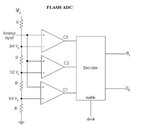Osawa_Odessa
Banned

- Joined
- Dec 31, 2012
- Messages
- 168
- Helped
- 1
- Reputation
- 2
- Reaction score
- 1
- Trophy points
- 1,298
- Activity points
- 0
Hi,
I want to ask a question about how to choose Vref (reference voltage) for flash ADC.
For example, I want to design a 2-bit flash ADC like this:

And the input voltage like this:

I wonder how can I choose reference voltage to get better precision.
Thanks for help.
I want to ask a question about how to choose Vref (reference voltage) for flash ADC.
For example, I want to design a 2-bit flash ADC like this:

And the input voltage like this:

I wonder how can I choose reference voltage to get better precision.
Thanks for help.



